This post may contain affiliate links. Please read our disclosure policy.
Zha Jiang Mian is a classic northern Chinese dish featuring savory pork sauce over chewy noodles, topped with fresh veggies. Easy, flavorful, and perfect for weeknight dinners.

If I had to choose a bowl of noodles that instantly gives me that “home-cooked meal” feeling, Zha Jiang Mian would be right at the top. It’s hearty, savory, a little salty, a little sweet, and so incredibly satisfying. The name literally means “fried sauce noodles” in Chinese, but that simple translation barely scratches the surface of what this dish means to those who grew up eating it.
A Little Background
Zha Jiang Mian comes from northern China, particularly Beijing, where wheat-based noodles are a staple of everyday meals. It’s traditionally made with thick wheat noodles topped with a rich, savory sauce made from fermented bean pastes and minced pork. The sauce is stir-fried (“zha”) until the oil separates and the flavor deepens. Then it’s spooned generously over chewy noodles and topped with crisp, refreshing vegetables.
The contrast of rich sauce and crisp veggies is part of what makes this dish so craveable. It’s humble, fast, and totally satisfying. And the best part? Once you’ve got the key ingredients, it’s very easy to recreate at home.
Why You’ll Like This Recipe
1. Big flavor, simple ingredients: The sauce packs deep umami flavor using just a few pantry staples.
2. Customizable: Works with pork, beef, tofu, or mushrooms — and any noodles you have on hand.
3. Make-ahead friendly: The sauce freezes well for future easy meals.
4. Balanced and fresh: Rich, savory sauce meets crisp, refreshing veggie toppings.
Zha Jiang Mian (炸酱面) (Chinese Fried Sauce Noodles)
Ingredients
- 450 g fresh wheat noodles or fresh udon noodles
Minced pork and sauce:
- 3 Tbsp fermented bean paste
- 1 Tbsp Sweet bean sauce (tian mian jiang)
- 2 Tbsp shaoxing wine
- ¼ cup water
- 2 Tbsp oil
- 224 g skinless pork belly diced
- 6 stalks green onion separate the green and white parts
- 1 star anise
- 1 Tbsp sugar or more as needed
- Salt to taste
Serve with:
- 1 large cucumber seeded and julienned
Instructions
- You can read more details on ingredients, substitutions, variations, and other tips in my post that may answer your questions not covered in the recipe card
Prepare the meat sauce:
- Whisk fermented bean paste, tian mian jiang, shaoxing wine, and 1/4 cup of water in a bowl until combined

- Preheat the oil in a wok or skillet over medium heat. Add the diced pork belly and cook until the pork started to get light brown on some spots.

- Add the star anise, the white part of green onion and continue cooking for another 3 minutes

- Stir in the bean paste mixture and sugar and cook for about 2 minutes over medium heat until the sauce starts to sizzle. Lower the heat to let it simmer and the sauce will thicken and darken in color, about 5 minutes or so. Have a taste and adjust by seasoning with more salt and/or sugar if needed. The sauce should be savory with hint of sweetness

- Add the finely chopped green part of the green onion. The sauce will look separate and oily and that's the way it supposed to be

Cook the noodles:
- Cook the noodles only when you are ready to serve. Cook the noodles according to the instructions on the package. Don't rinse the noodles so the sauce clings to the noodles.

- Ladle the meat sauce over noodles and toss the noodles to prevent the noodles from sticking. Top with cucumber and chopped green onion. Serve immediately
*Nutrition facts are just estimates and calculated using online tools*

Ingredients Breakdown (and Substitutions)
Here’s a quick breakdown of the signature ingredients — and what to do if you can’t find them all.
1. Tian Mian Jiang (甜面酱) – Sweet Bean Paste
This thick, dark paste is made from fermented wheat flour and soybeans. Despite the name, it’s more savory than sweet, with a mellow, umami-rich depth. It’s one of the defining flavors of Beijing-style Zha Jiang Mian.
Where to find it: Asian grocery stores (look for jars labeled “Sweet Flour Sauce” or “Tian Mian Jiang”) or online.
Substitute: If it’s hard to find, try this DIY blend: 1 tablespoon hoisin sauce + 1 teaspoon white or red miso paste
This combo gives you the sweetness and the fermented funk that mimic the original.
2. Fermented bean paste
This adds a salty, savory punch and fermented depth. It’s earthier and more intense than sweet bean paste, and together they create a complex, layered sauce.
Where to find it: Often in jars labeled “Fermented Yellow Bean Paste” or “Soybean Paste” at Asian stores.
Substitute: You can use doubanjiang in a pinch (but lesser amount because it’s spicier) or use miso paste (milder in flavor)
3. Ground pork
The classic choice. It brings the right amount of fat and flavor to carry the sauce.
Substitute: Ground beef or ground turkey work well. For vegetarian: finely chopped mushrooms or crumbled extra-firm tofu soak up the sauce beautifully.
4. Noodles
Thick, chewy wheat noodles are best. In Beijing, these are usually handmade or fresh knife-cut noodles.
Substitute: Udon noodles (great texture match), thick lo mein noodles, even spaghetti will do in a pinch — just don’t overcook!
5. Fresh toppings
These are optional but highly recommended. They add contrast and crunch. You can use one or more of any of these veggies: julienned cucumber (classic), shredded carrots, fresh bean sprouts, green onions, sliced radishes or cabbage
Variations & Tips
1. Make It Spicy:
Stir in a spoonful of doubanjiang or chili crisp at the end, or drizzle with chili oil before serving.
2. Vegetarian Version:
Use mushrooms and tofu for the sauce base, and consider adding a splash of soy sauce or a pinch of MSG to boost umami
3. Meal Prep Friendly:
Double the sauce and freeze it in small containers. It reheats beautifully and turns into an instant meal when tossed with hot noodles.
Zha Jiang Mian is one of those dishes that proves just how good simple food can be. A few pantry staples, a handful of fresh toppings, and boom — dinner that hits every note. It’s deeply savory, just a little sweet, and completely comforting. And when you’ve had a long day or just need a big bowl of something that feels like a hug? This is it.
If you haven’t tried it before, I hope you’ll give it a go. And if you grew up eating it — maybe this version will bring back a little nostalgia with each bite.

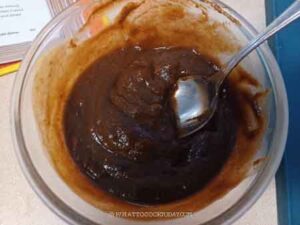
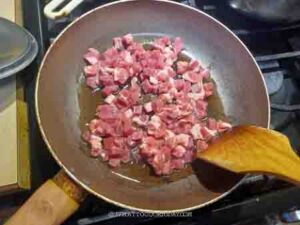
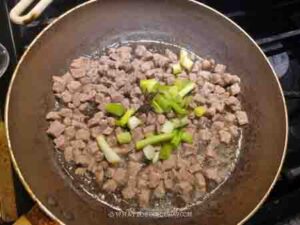
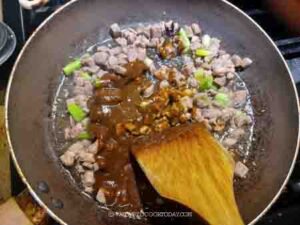
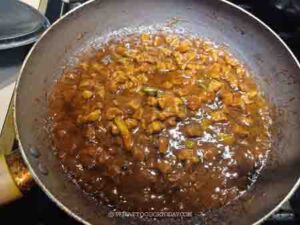


2 comments
This is literally my favorite dish! I’m so glad to have stumbled onto your recipe and I can’t wait to give it a go!!!
Thank you so much Rebecca. I hope you like it if you give it a try! Please let me know if you have a chance to do so.